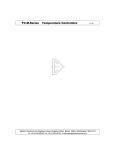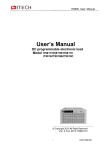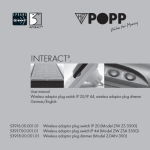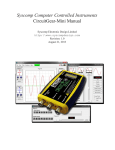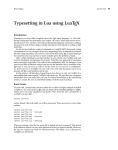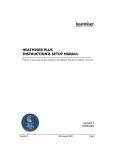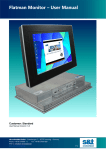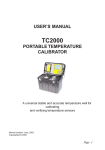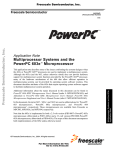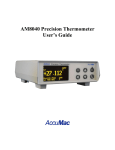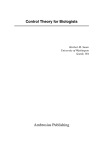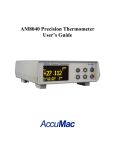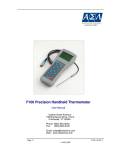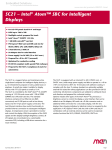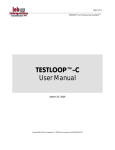Download TC M User Instructions 108
Transcript
TC M-Series Temperature Controllers V1.08 Electron Dynamics Ltd, Kingsbury House, Kingsbury Road, Bevois Valley, Southampton, SO14 OJT Tel: +44 (0) 2380 480 800 Fax: +44 (0) 2380 480 801 e-mail [email protected] TC M Temperature Controller User Manual V1.08 Index 1 2 Introduction..............................................................................................................................1 Controller Functions ................................................................................................................2 2.1 Sensor measurement.....................................................................................................2 2.2 CPU ................................................................................................................................2 2.3 Output driver...................................................................................................................2 2.4 Communications.............................................................................................................2 2.5 Power..............................................................................................................................2 3 Connections.............................................................................................................................3 3.1 PT100 Measurements....................................................................................................3 3.2 PT1000 Measurements..................................................................................................3 3.3 Voltage sensor measurements.....................................................................................3 3.4 NTC thermistors .............................................................................................................3 3.5 Other temperature sensors............................................................................................4 3.6 TEC connection..............................................................................................................4 3.7 Power connection...........................................................................................................4 3.8 Alarm output ...................................................................................................................4 3.9 Inhibit ..............................................................................................................................4 3.10 USB.................................................................................................................................4 3.11 PCB Connector / Link positions...................................................................................4 4 LED Status...............................................................................................................................5 5 Thermal Issues........................................................................................................................5 5.1 Sensor Selection ............................................................................................................5 5.2 Thermal Assembly .........................................................................................................5 5.2.1 Heat sink size ........................................................................................................5 5.3 Thermal Conduction.......................................................................................................5 5.4 Peltier Size .....................................................................................................................6 5.5 Drive Limit.......................................................................................................................6 5.6 Important stability issues ...............................................................................................6 6 Temperature Controlling .........................................................................................................6 6.1 Off mode.........................................................................................................................6 6.2 On/Off control .................................................................................................................6 6.3 PID Control .....................................................................................................................7 6.4 Tuning the PID parameters............................................................................................7 6.5 Temperature test mode..................................................................................................7 6.6 Relay Feedback – Autotuning .......................................................................................8 6.7 Ziegler - Nichols open loop – step response ..............................................................8 6.8 Ziegler - Nichols closed loop – ultimate gain method.................................................8 7 Graphical User Interface.........................................................................................................8 7.1 Pull Down Menus ...........................................................................................................9 7.1.1 File Menu...............................................................................................................9 7.1.2 Port ........................................................................................................................9 7.1.3 Help........................................................................................................................9 7.2 Control ............................................................................................................................9 7.2.1 Type.......................................................................................................................9 7.2.2 None ......................................................................................................................9 7.2.3 On/Off ....................................................................................................................9 7.2.4 Proportional .........................................................................................................10 7.2.5 Integral.................................................................................................................10 7.2.6 Derivative.............................................................................................................10 7.2.7 Derivative Filter ...................................................................................................10 7.2.8 Dead band...........................................................................................................10 Electron Dynamics Ltd page 1 TC M Temperature Controller User Manual V1.08 7.2.9 Power Up State ...................................................................................................10 7.3 Set point........................................................................................................................10 7.3.1 Method.................................................................................................................10 7.3.2 Pot Range............................................................................................................11 7.3.3 Pot Offset.............................................................................................................11 7.3.4 PC Set Point........................................................................................................11 7.3.5 Control .................................................................................................................11 7.3.6 Output ..................................................................................................................11 7.4 Sensor ..........................................................................................................................11 7.4.1 Type.....................................................................................................................11 7.4.2 X2, X, C Coefficients...........................................................................................11 7.4.3 NTC thermistors ..................................................................................................12 7.4.4 Units.....................................................................................................................12 7.5 Output ...........................................................................................................................12 7.5.1 Polarity.................................................................................................................12 7.5.2 Minimum ..............................................................................................................12 7.5.3 Maximum .............................................................................................................12 7.5.4 Frequency............................................................................................................12 7.6 Alarms...........................................................................................................................12 7.6.1 Minimum Alarm ...................................................................................................12 7.6.2 Maximum Alarm ..................................................................................................12 7.6.3 Minimum OK Temperature .................................................................................12 7.6.4 Maximum Temperature.......................................................................................12 7.6.5 Operational temperature max (Only available on certain GUI).........................12 7.6.6 Maximum Temperature (Only available on certain GUI)...............................12 7.7 Report ...........................................................................................................................13 7.7.1 Set point ..............................................................................................................13 7.7.2 Temperature........................................................................................................13 7.7.3 Control .................................................................................................................13 7.7.4 Output ..................................................................................................................13 7.7.5 Alarms..................................................................................................................13 7.7.6 Faults ...................................................................................................................13 7.7.7 Temperature OK .................................................................................................13 7.8 Reading and Setting Parameters ................................................................................13 7.8.1 Read Button ........................................................................................................13 7.8.2 Write Button.........................................................................................................13 7.9 Figure TC M series Temperature Controller GUI (Java)............................................14 7.10 C++ GUI........................................................................................................................14 7.10.1 Additional features ..............................................................................................14 7.10.2 Data Logging.......................................................................................................15 7.10.3 C++ GUI ..............................................................................................................15 8 Communication Protocol.......................................................................................................15 9 Specification TC M Series ...............................................................................................16 9.1 Supply...........................................................................................................................16 9.2 Output ...........................................................................................................................16 9.3 Control ..........................................................................................................................16 9.4 Set point........................................................................................................................16 9.5 Alarm.............................................................................................................................16 9.6 Sensor ..........................................................................................................................16 9.7 Measurement Accuraccy .............................................................................................16 9.8 User ..............................................................................................................................16 9.9 Format ..........................................................................................................................16 Electron Dynamics Ltd page 2 TC M Temperature Controller User Manual V1.08 10 Sources of Information .....................................................................................................17 There is a lot of information on the internet with some of it relevant have a look at these -......17 Electron Dynamics Ltd page 3 TC M Temperature Controller User Manual V1.08 1 Introduction Our TC M series of Temperature Controllers are designed for use with thermoelectric coolers also known as TEC’s or Peltier devices. These offer precise temperature control from –200 ºC to 100ºC at up to 0.001ºC stability. Our controller can be setup or controlled from a PC via USB this allows access to output limits, PID terms, deviation alarms and operating modes. A typical use for any precise temperature control system would be with laser diodes, infrared detection, high gain amplifiers and cold plate assemblies. The TC M series temperature controller is suitable for controlling single and multiple TEC arrays. It provides a pulse width modulated output which effective provides a continuously variable output for cooling and heating. It is programmable from a PC allowing configuration and tuning to meet system requirements. This configuration data is stored internally allowing standalone operation once programmed. Its interface and command set allow the unit to be controlled remotely, in particular this allows changing of the set point and alarm temperature settings. Electron Dynamics Ltd page 1 TC M Temperature Controller User Manual V1.08 2 Controller Functions The controller has the following functional parts – 2.1 Sensor measurement The input stage provides measurement for resitive and voltage output sensors. These are measured by a sophisticated delta-sigma ADC which gives excellent accuracy and noise suppression. Suitable for Pt100 sensors - 100 R accuracy 0.001 C over –200 to +400 C range Voltage sensors accuracy 0.01 mv or better 2.2 CPU This provides all the intelligent control, measuring the input values and calculating the output required for the control type. It also provides storage for the configuration parameters . 2.3 Output driver This provides a bi-directional variable output drive to the TEC element(s). The output switches at the preset repetition rate and adjusting for output value by setting the PWM duty cycle. 2.4 Communications This is provided via USB 2.5 Power The drive to the TEC’s is provided directly from the voltage supplied so this should be the same as the TEC’s maximum rating or less. Electron Dynamics Ltd page 2 TC M Temperature Controller User Manual V1.08 3 3.1 Connections PT100 Measurements For PT100 measurements configure the following links on the TCM PCB Lk1 connect pins 2 and 3 No other links Connect PT100 sensor to J8 on pins 3 and 4 with screen to pin 6. 3.2 PT1000 Measurements For PT1000 measurements configure the following on the TC M PCB. LK1 connect pins 2 and 3 No other links Connect PT1000 sensor to J8 on pins 3 and 4 with screen to pin 6. 3.3 Voltage sensor measurements For voltage outputs sensors, LM35, LM50, LM51, LM 60, LM 61 configure the following links on the TCM PCB Lk1 link pins 1 and 2 Lk2 link pins 2 and 3 No other connections Connect sensor to J8, Sensor + to pin 1, sensor output to pin 3 and sensor gnd to pin4 with screen if used to pin 6. In this configuration LM35 operates down to zero degrees C but not below 3.4 NTC thermistors To connect NTC thermistors – LK1 link pins 1 and 2 LK2 link pins 2 and 3 LK4 link pins 1 and 2 No other connections Connect thermistor to J8 between pins 3 and pins 4, connect screen if used to pin 6 For best operation stick with 10K types these have a better range in this circuit. Other values can be accommodated if required Electron Dynamics Ltd page 3 TC M Temperature Controller User Manual V1.08 Consult Electron Dynamics for possibilities 3.5 Other temperature sensors These are possible please consult Electron Dynamics for advice. 3.6 TEC connection Connect to J3 noting polarity, actual drive polarity can be configured by software 3.7 Power connection Power should be applied to J2 3.8 Alarm output This is provided from J4, this is active when low. 3.9 Inhibit This is provide from J1 and inhibits the drive when the pins of j1 are connected together. For multiple uses the TCM temperature controller can be made to inhibit control of other TCM controllers by its alarm output indicated by LED2. To achieve this, the alarm output will need to be daisy chained to the inhibit switch of the respective controller. 3.10 USB This is provided from J5. Note this operates as a virtual COM port 3.11 PCB Connector / Link positions TCM PCB viewed from top Power / Peltier Connector Temp OK LED Temp Alarm LED Inhibit I/P Alarm O/P Sensor 1 + LK3 S1 1 1 D connector Screen LK1 LK2 LK4 Links Electron Dynamics Ltd page 4 TC M Temperature Controller User Manual V1.08 4 LED Status The TCM series temperature controller has two LEDs that show the status of the controller. TEMP OK ( LED 1) ON – Temperature ok in relation to set point and user defined settings TEMP OK (LED 1) OFF – Temperature out of range TEMP ALARM (LED 2) ON – Indicates an alarm or inhibit (External or Internal ) TEMP ALARM (LED 2) OFF – Temperature controller working correctly 5 Thermal Issues 5.1 Sensor Selection The TCM series of temperature has many options for different sensor types. Each sensor type has different characteristics which will affect your choice Sensor type Accuraccy Resolution Range PT100 RTD <0.1 deg <0.005 deg -260 to +850 deg C LM35,LM50 etc <2 deg < 0.005 deg -40 to 100 deg C There are variations in size with some types so choose a suitable size for your application. 5.2 Thermal Assembly This is a critical component in the system design, typically there are 2 problems – - the heatsink is not large enough - the thermal conduction between components is poor It is worth reading the extensive material available from the peltier / TEC manufacturers to find out the requirements for this. See www.marlow.com and www.lairdtech.com 5.2.1 Heat sink size The size of this should be chosen using the manufacturers calculations, it will need to be large enough to radiate the heat required, typically they have a large heat capacity but often are more limited in there capability to dissipate the heat. This is often seen when operating under temperature control there is a continuous rise in heatsink temperature or rise in drive current. It should be noted that there is a point in where the system can go into thermal runaway, as the heatsink is unable to dissipate the heat properly and the temperature of the sample and heatsink will continuously climb. So this should be chosen to be larger than necessary. Also using a fan on the heatsink can improve the thermal resistance to air by as much as 3 times so this will give a significant improvement. 5.3 Thermal Conduction It is important to ensure that there is a good thermal path between the Sample, TEC and heatsink. Not only does this provide good heat removal / dissipation but will improve the temperature stability. Also important is that the mating surfaces are reasonably flat and that just enough heatsink Electron Dynamics Ltd page 5 TC M Temperature Controller User Manual V1.08 compound is used to make the thermal connection. A misconception is that more compound will be better, but this reduces the thermal connection, always dramatically compromising the temperature stability. 5.4 Peltier Size This should be calculated from the manufacturers selection. It is important that the TEC is not driven beyond its maximum, the device will certainly be damaged if the maximum current is exceeded. Due to the nature of the peltier device as the drive is increased above between 60 and 80% of maximum it becomes progressively less efficient and in this situation will tend to just provide more local heating that heat pumping. This can possibly lead to thermal runaway if the limit is not set . We feel that there is little point in working the devices in their inefficient region and recommend that device are run at a maximum of 80% of maximum drive. 5.5 Drive Limit On the TC M series the TEC drive limits allow maximum cooling and heating rates. Where the maximum drive is 100%. So to reduce a 12v device to half power, if we are powered at 12v then the max and mins should be –50% and 50%. The situation if powered from 9v would be 9/12 * 100 = 75% 5.6 Important stability issues Some important factors to remember. Facilitate faster settling time and response - by reducing thermal mass of sample - reduce distance between TEC and item being cooled Improve accuracy by locating sensor near to cooled device as possible. Reduce thermal load by reducing thermal feedback from heatsink to sample by using thermal insulation. 6 Temperature Controlling 6.1 Off mode This is purely a mode in which under temperature control the output drive is off. This is intended for diagnostics or to ensure a failsafe condition. 6.2 On/Off control This mode of temperature control is the most basic, it benefits from being relatively easy to set up. Simply specify the setpoint, and dead band. However there are some problems with this approach, due to full on / full off nature of the output, the temperature stability is relatively poor. Though will be sufficient for some applications. The other problem is that TEC is cycled fully heating and the fully cooling, this may cause reliability issues with the TEC itself. Electron Dynamics Ltd page 6 TC M Temperature Controller User Manual V1.08 6.3 PID Control PID control comprises of 3 elements Proportional, Integral and Derivative. These can be operated separately or together, the selection can made through the modes or by the PID values themselves. The Proportional term provides a variable output which as the temperature deviates further from the set point then the output drive increases until the maximum is reached. The response of this is defined by the value of the P term. Where Output = (setpoint-actual temperature ) * proportional term The main problem with Proportional only control is there is always a temperature error, this is due to the fact that in order to provide an output then there needs to be a temperature error. Using an integral term overcomes the problem of steady state errors, practically it acculmulates any error and applies this to the output drive to compensate, Increasing or decreasing it accordingly. Though there are direct benefits in temperature accuracy there is some sacrifice in system stability particularly as the integral effect is increased. The derivative term provides an output proportion which varies with the rate of the input error or output. This provides a faster response to temperature variations and also provides a stability balancing effect to the integral term. Please note that for best stability there must be a fixed ratio between the I term and the D term normally 4 to 1. Due to the inherently large gain of the derivative at high frequencies at filter, the derivative TC is provided to attenuated high frequency noise. 6.4 Tuning the PID parameters The PID parameters can be tuned using various methods, There are many methods of tuning the PID parameters required, some of these also allow you to tailor the response in certain ways. Three of the main ones are – Relay feedback – closed loop Ziegler - Nichols open loop – step response Ziegler – Nichols closed loop – ultimate gain method The basic methods are mentioned below however you should look at the articles available for detailed explanation. 6.5 Temperature test mode Temperature test mode introduces the option of having a series of setpoints, according to which the control loops through after specified intervals characterized for each setpoint. Along with that there exist a rate control. Being associated with every set point, this control defines the rate at which the next set point should be approached after the end of intended time-interval. A maximum of five different set points could be used at this mode. Electron Dynamics Ltd page 7 TC M Temperature Controller User Manual V1.08 6.6 Relay Feedback – Autotuning The TC M features an auto tuning function as standard using the relay feedback method, this makes this tuning very much easier. The user is able to select the setpoint around which the auto tuning should occur and how long for the unit to make measurements. The unit then sets up the relay feedback conditions under which oscillation occurs, these peaks are analysed and from these the PID parameters are calculated. The test aborts at the end and uses the new PID parameters for temperature control. 6.7 Ziegler - Nichols open loop – step response This is open loop so there is no the control function is off, it involves making a step change at the output The input / thermal response should be noted, then using graphical means should be analysed, to give the initial process dead time and the process time constant. From these the respective terms can be calculated Td is Process time constant t is pseudo dead time and Kp the process gain From this the PID terms are calculated P term is 1.2 ( t/ ( Td * Kp) ) I term is Td / 0.5 and D term is Td * 0.5 6.8 Ziegler - Nichols closed loop – ultimate gain method This is a closed loop so the control function in on. With the P term set low and the I term and D term off. Monitoring the temperature the gain or P term is increased until there is sustained and continuous oscillation of the temperature. The Gain ( P term ) required and the period of the oscillation should be noted. From these the PID terms can be calculated. Where Gu is the gain and Tu is the period From this the PID terms can be calculated Where P term = 0.6 Gu I term = 0.5* Tu 7 D term = 0.125 Tu Graphical User Interface The TCM series Temperature Controller can be operated via the Graphical User Interfaces, one written in Java and the other in C++. They are very similar with minor differences. The GUI will be broken down into eight functional categories, each will be explained in the remainder of this section of the manual: I. Pull Down Menus II. Control III. Set Point IV. Sensor Electron Dynamics Ltd page 8 TC M Temperature Controller User Manual V1.08 V. Output VI. Alarms VII. Report 7.1 7.1.1 Pull Down Menus File Menu Save as defaults allows the user to save a copy of the current GUI set up, which can be loaded using the load defaults command. The exit command closes the GUI. 7.1.2 Port The desired communication port can be chosen and the TCM Series Temperature Controller can be connected or disconnected. Please note port needs to be selected and opened at the outset in order to communicate with the controller. 7.1.3 Help Displays help information 7.2 Control 7.2.1 Type The control algorithm can be single or a combination of Proportional, Integral, Derivative terms. The list box allows the user to define the controller terms required. The available options are; 0. None 1. On/Off 2. Proportional 3. Proportional and Integral 4. Proportional, Integral and Derivative User defined values can manually be entered here for the controller to operate from. 7.2.2 None This is a default off mode for diagnostic or fail safe purposes. 7.2.3 On/Off With On /off control the output drive is only fully On, heating or cooling or off. Electron Dynamics Ltd page 9 TC M Temperature Controller User Manual V1.08 Its response is – Temperature > setpoint + deadband Fully Cooling Temperature < setpoint - deadband Fully Heating Temperature <setpoint +deadband and >setpoint-deadband output off 7.2.4 Proportional With proportional action, the controller output is proportional to the temperature error from the setpoint. The proportional terms sets the gain for this where Output = (setpoint-actual temperature ) * proportional term 7.2.5 Integral With integral action, the controller output is proportional to the amount of time the error is present. Integral action eliminates offset. The integral term is a time unit in seconds. NB for larger effects of integration reduce the integral time, also for operation without integral, integral time can be set to a large number e.g. 1,000,000. 7.2.6 Derivative With derivative action, the controller output is proportional to the rate of change of the measurement or error. The controller output is calculated by the rate of change of the measurement with time, in seconds. To increase the derivative action increase the derivative value. See also Derivative Filter. 7.2.7 Derivative Filter The derivative filter is a low pass filter function on the derivative value. This allows the filtration of noise components which are a problem with a pure derivative function. The filter value should be set to between 0 and 1. 7.2.8 Dead band For use with On/Off control the dead band specifies the temperature range around the set point where the output is zero. 7.2.9 Power Up State This sets the temperature control state from power up, where this can be set as On or Off or where Last is selected it sets its last setting prior to power off. 7.3 Set point 7.3.1 Method The temperature set point can be set via the PC or by altering the pot on the TCM series Temperature controller hardware. Electron Dynamics Ltd page 10 TC M Temperature Controller User Manual V1.08 For setting via the PC select the PC radio button and enter the set point value into the edit box directly following the radio button. 7.3.2 Pot Range This sets the temperature range that the pot gives values for. 7.3.3 Pot Offset This sets the minimum temperature point on the pot. 7.3.4 PC Set Point This allows the set point to be fixed via the GUI 7.3.5 Control The control radio button if checked inhibits the temperature control. 7.3.6 Output The output edit box allows the a fixed output to be set. To use this the control should be disabled otherwise any setting made will be over ridden by the control. Range 0 to +/- 1000 7.4 Sensor 7.4.1 Type The supported sensor types are selectable from the list box; refer to the specification section 7.6 in this manual for supported temperature sensors. 7.4.2 X2, X, C Coefficients These are quadratic coefficients than can be input to convert the sensor voltage measured into a temperature. This can be used for other sensors so that these can calibrated. Where temperature = (v * v * X2 ) + (v * X) + C v is measured sensor voltage and temperature is calculated temperature The C term allows the user to adjust / shift the temperature to compensate for variations in sensor accuracy. It can be seen that this value simply added to the temperature value. So if your sensor was 1 degree out then make C = 1. Also provided is buttons to decrease / increase this value in 1 degree steps. For NTC thermistors different parameters are required Electron Dynamics Ltd page 11 TC M Temperature Controller User Manual V1.08 7.4.3 NTC thermistors For NTC thermistors different parameters are required . Beta as specified for thermistor type Resistance at 25 deg C C coefficient degree offset Rl drive resistance on TCM 22000 as standard 7.4.4 Units The temperature can be displayed in degrees Centigrade, Kelvin or Fahrenheit. 7.5 7.5.1 Output Polarity This sets the polarity of the output drive, 7.5.2 Minimum Sets the minimum value limit of the output. Range 0 to +/- 1000 7.5.3 Maximum Sets the maximum value limit of the output. Range 0 to +/- 1000 7.5.4 Frequency Sets the PWM repetition frequency of the output drive. Range 20 to 1000 Hz 7.6 7.6.1 Alarms Minimum Alarm Sets the temperature below which the alarm is activated. Select via check box to enable. 7.6.2 Maximum Alarm Sets the temperature above which the alarm is activated. Select via check box to enable. 7.6.3 Minimum OK Temperature Sets the lower temperature difference point from the set point for temperature OK. 7.6.4 Maximum Temperature Sets the higher temperature difference point from the set point for temperature OK. 7.6.5 Operational temperature max (Only available on certain GUI) Sets the temperature maximum, above which the drive output is disabled. 7.6.6 Maximum Temperature (Only available on certain GUI) Sets the temperature minimum, below which the drive output is disabled.. Electron Dynamics Ltd page 12 TC M Temperature Controller User Manual V1.08 7.7 7.7.1 Report Set point Displays the set point, can be used to ensure the controller has accepted the set point entered in the control category; refer to section 5.3. 7.7.2 Temperature Displays the measured temperature, the measured temperature units can be Celsius, Fahrenheit or Kelvin and can be selected in the sensors category; refer to section 5.4.3 7.7.3 Control Displays the condition of the output drive either On or Off. 7.7.4 Output Displays the output value is set to. Range 0 to +/- 1000 7.7.5 Alarms Displays whether an alarm is active. 7.7.6 Faults Displays any fault codes. 7.7.7 Temperature OK Displays if the temperature is in the ok range 7.8 7.8.1 Reading and Setting Parameters Read Button The read button will load the respective GUI category with the current condition of the TC M Series Temperature Controller 7.8.2 Write Button The write button will load the TC M Series Temperature Controller with the current conditions entered in to the GUIs category. Electron Dynamics Ltd page 13 TC M Temperature Controller User Manual V1.08 7.9 Figure TC M series Temperature Controller GUI (Java) 7.10 C++ GUI There are minor differences with the Java GUI as below. 7.10.1 Additional features The C++ GUI has feature for test mode, temperature cycling and temperature ramping, also included is an auto-tuning algorithm for setting up the PID terms automatically. Electron Dynamics Ltd page 14 TC M Temperature Controller User Manual V1.08 7.10.2 Data Logging This function enables / disables a continuous stream of temperature and output information from the TCM controller. This is stored in a log file for compatible with excel for analysis. This allows the user to measure response graphs for tuning and stability anaysis. 7.10.3 C++ GUI 8 Communication Protocol Please see the commands file on the resources CD-ROM. Electron Dynamics Ltd page 15 TC M Temperature Controller User Manual V1.08 9 9.1 Specification TC M Series Supply 5v to 28v 9.2 DC Output 0 to 5A ( TC M 5A ), 0 to 10A ( TC M 10A ), 0 to 25A ( TC M 25A ) Bi-directional heating and cooling Variable output – 0 to +/- 1000 0.1% resolution PWM rate variable 20hz to 1000Hz 9.3 Control From PC via USB Programmable PID terms Will operate as P, PI, PID or On/Off with Hysterysis Resolution 0.001 deg C Max stability 0.001 deg C depending on thermodynamics /setup etc 9.4 Set point Set either by pot, or by PC 9.5 Alarm PC configurable TTL output, active low High temp. Low temp or out of band 9.6 Sensor Voltage, PT100, PT1000, LM35, LM50, LM60, LM61, NTC Thermistor, OTHER Other versions can be calibrated using the quadratic coefficients 9.7 Measurement Accuraccy PT100 0.001 deg C or better LM35 etc 0.001 deg C or better 9.8 User Windows control software allows access to all parameters Can be controlled within a process environment 9.9 Format PCB assembly or Module Electron Dynamics Ltd page 16 TC M Temperature Controller User Manual V1.08 10 Sources of Information There is a lot of information on the internet with some of it relevant have a look at these - http://www.peltier-info.com - TEC information site http://www.marlow.com -TEC manufacturer http://www.jashaw.com/pid/ - Control E book http://www.jashaw.com/pid/tutorial/pid6.html - PID tuning lecture notes http://www.brewerscience.com/cee/otherprods/cee_pid.html - PID notes http://lorien.ncl.ac.uk/ming/pid/PID.pdf - PID notes Electron Dynamics Ltd page 17





















